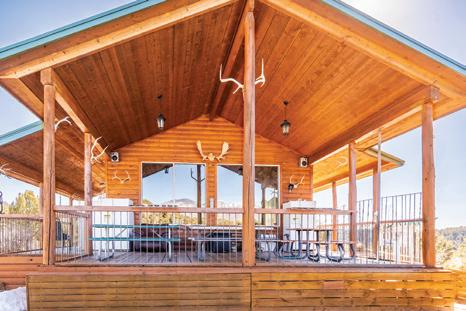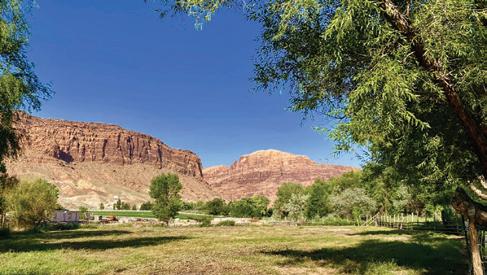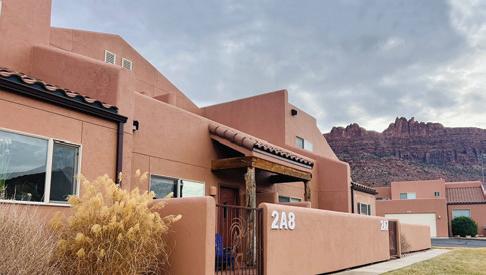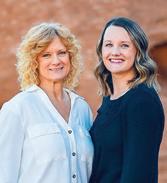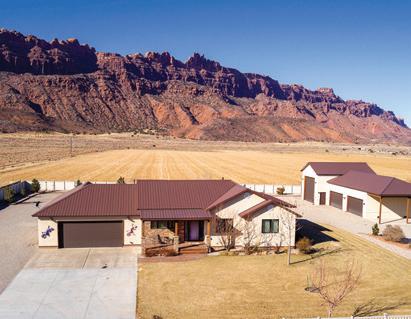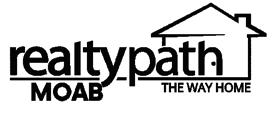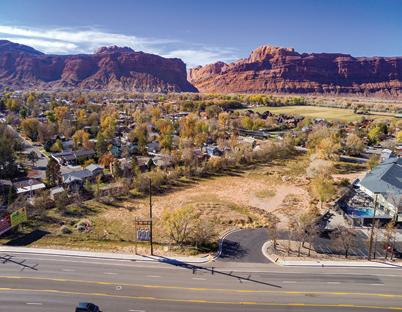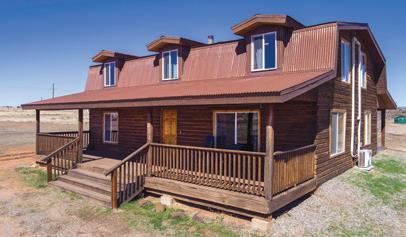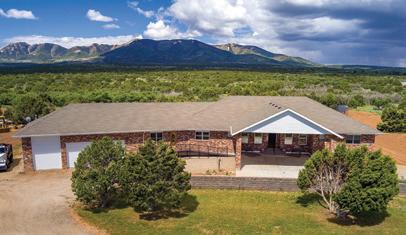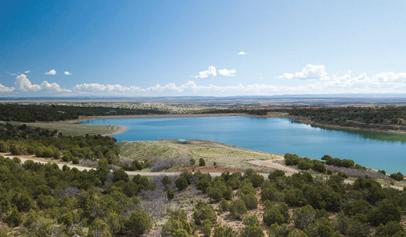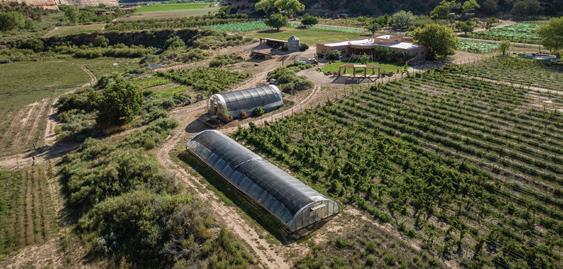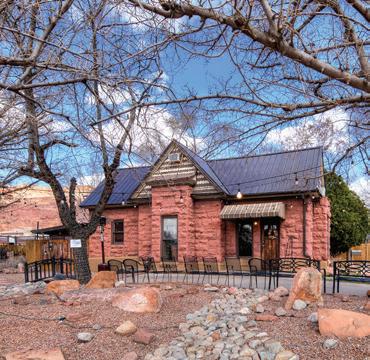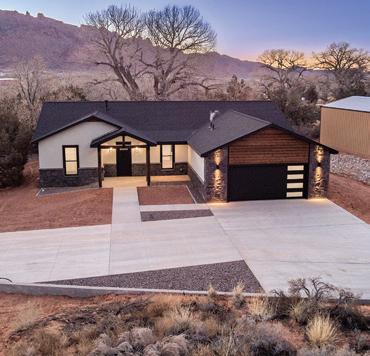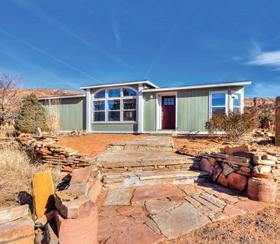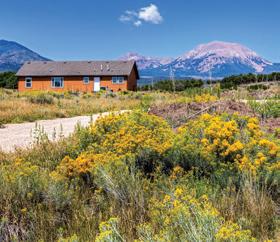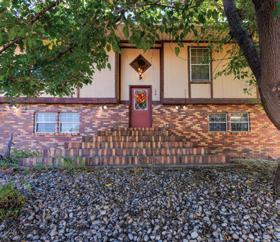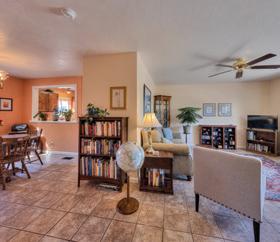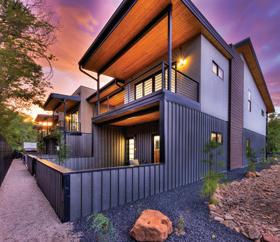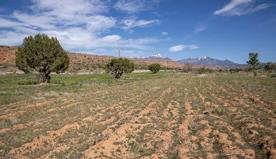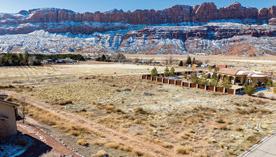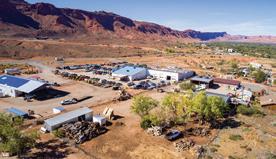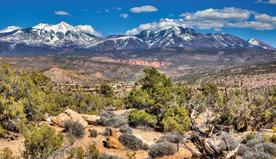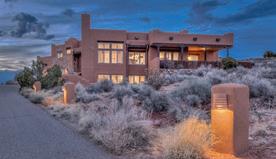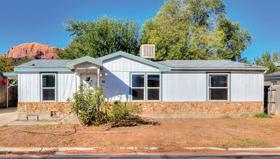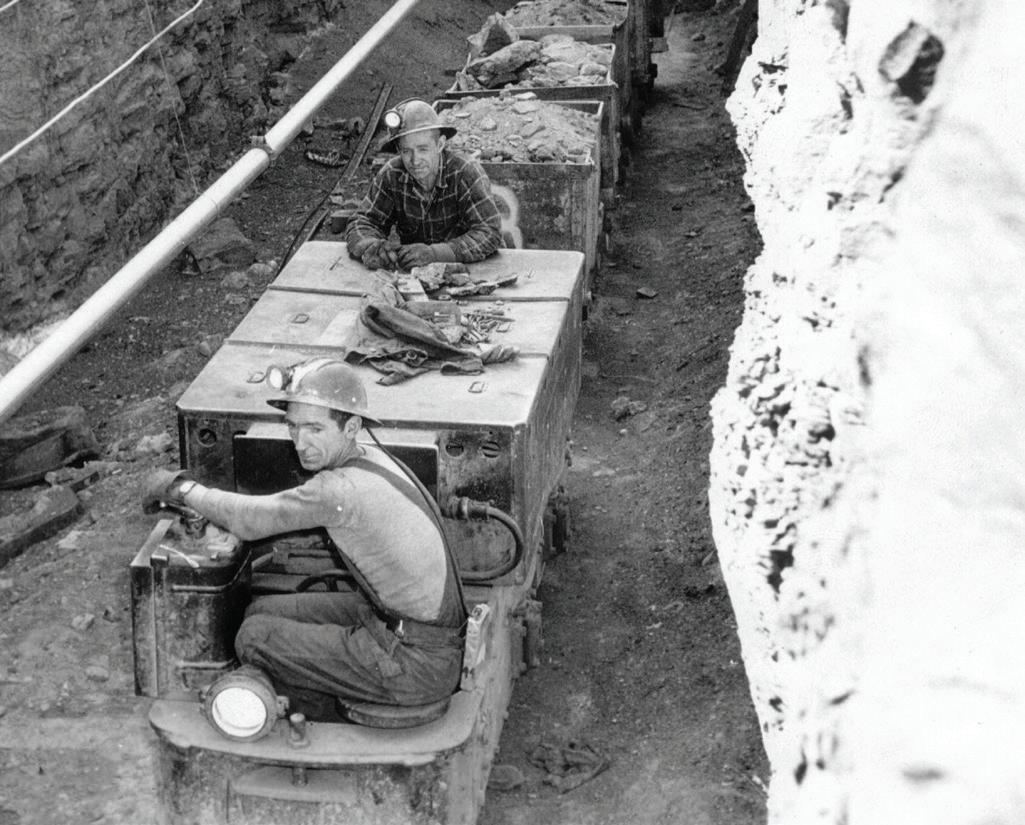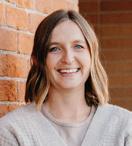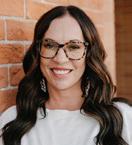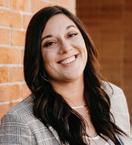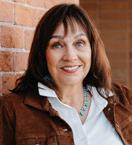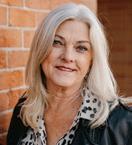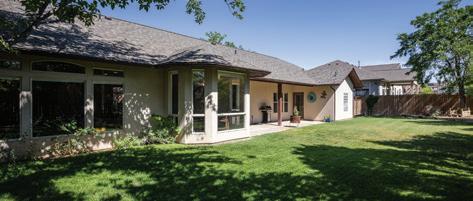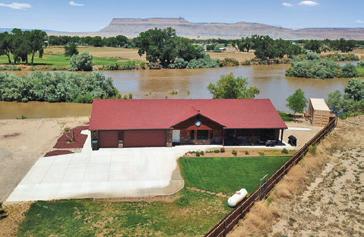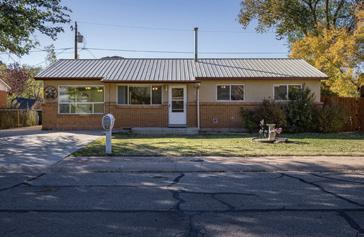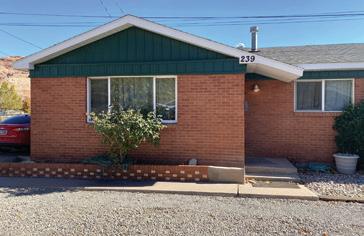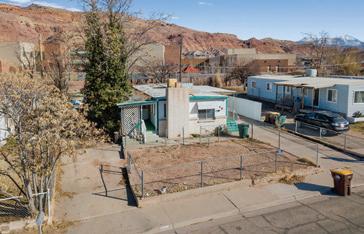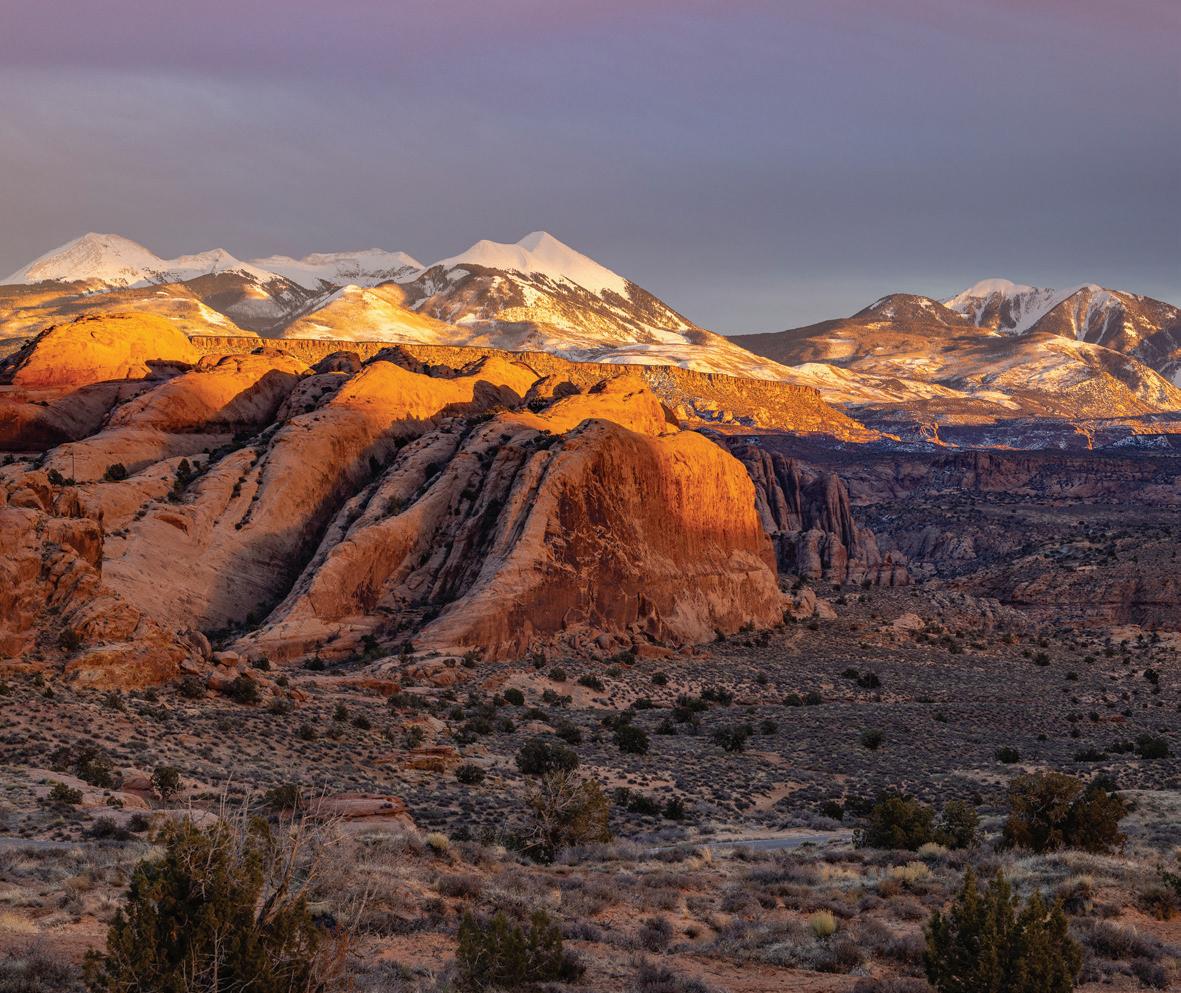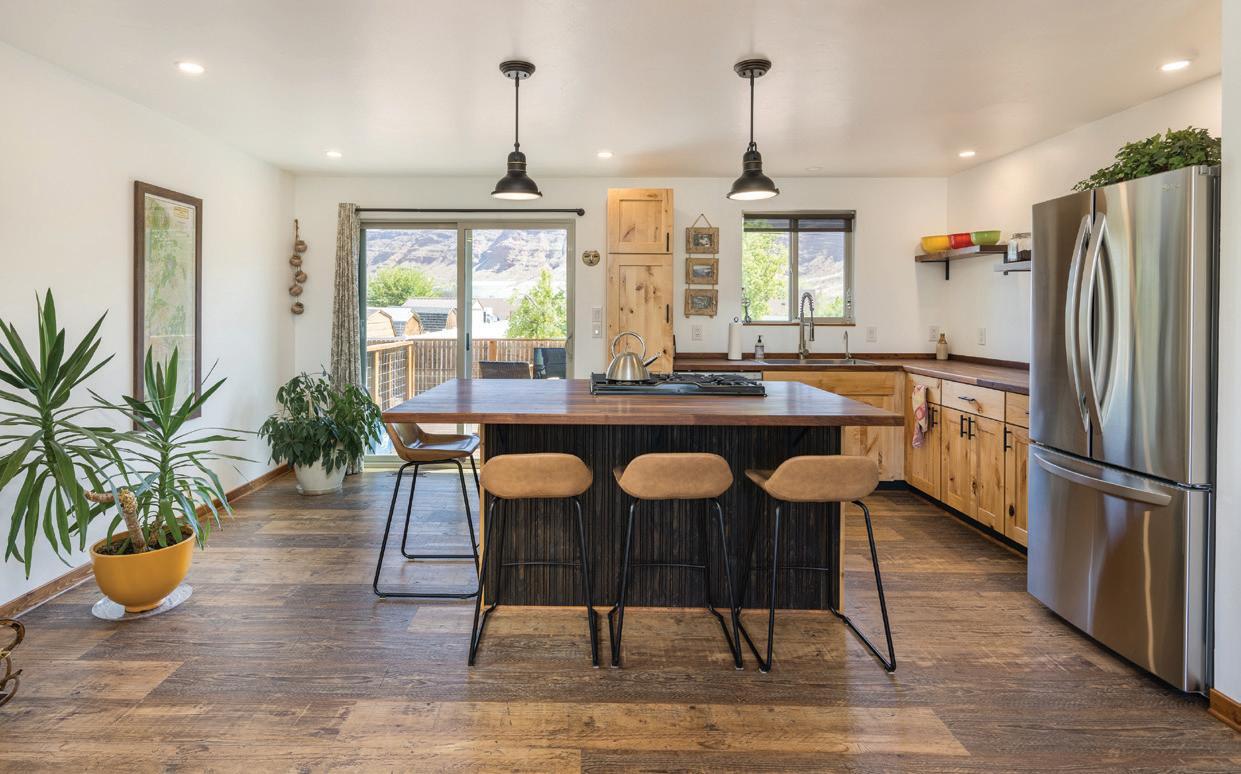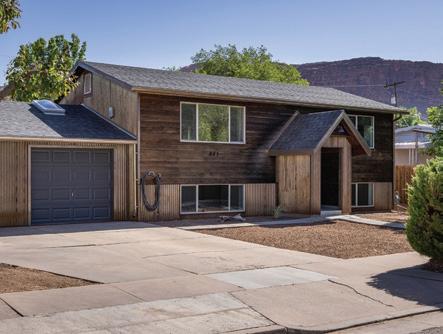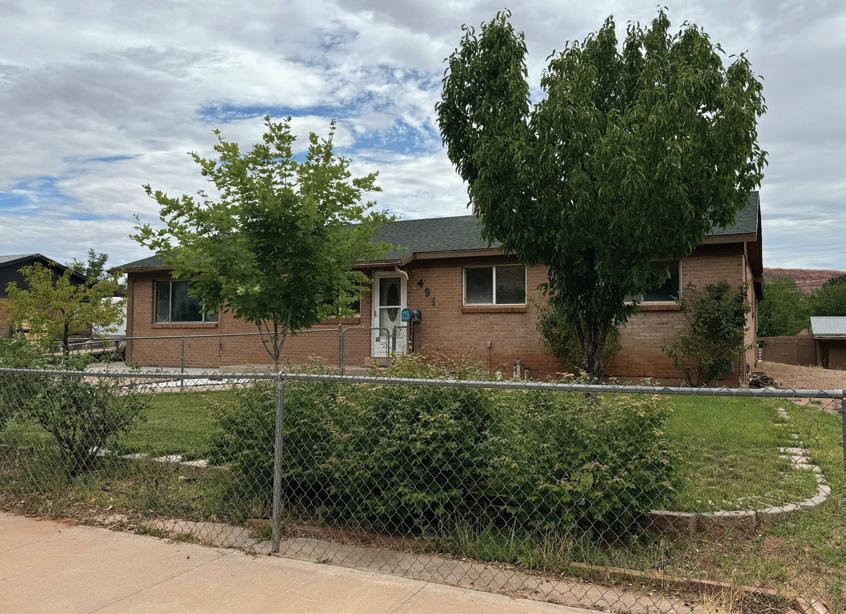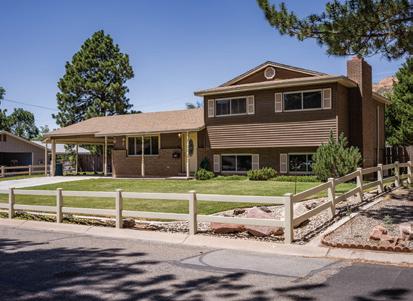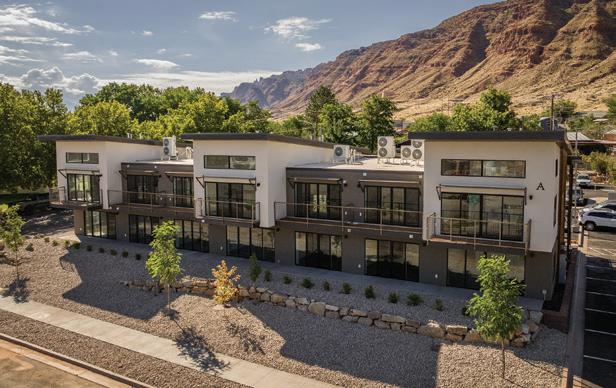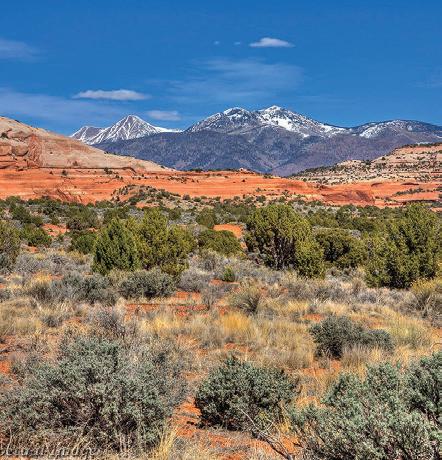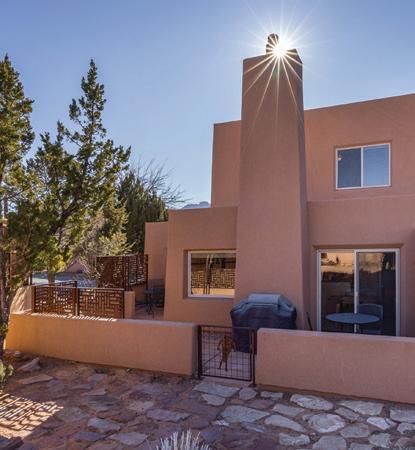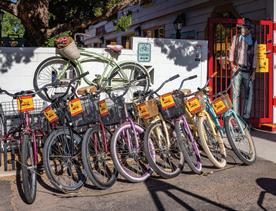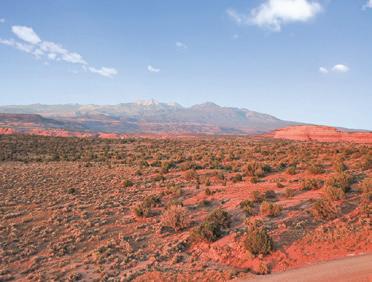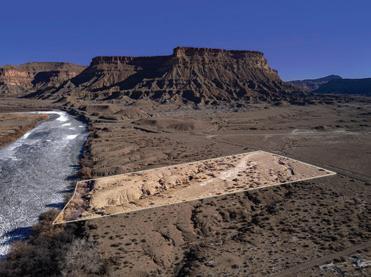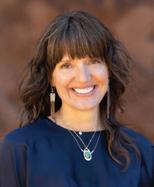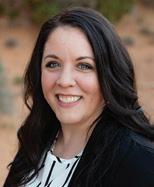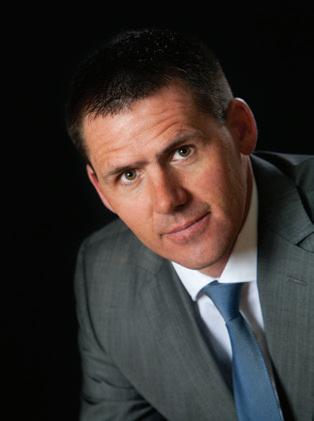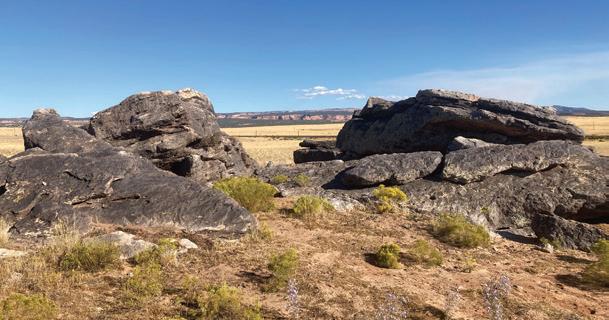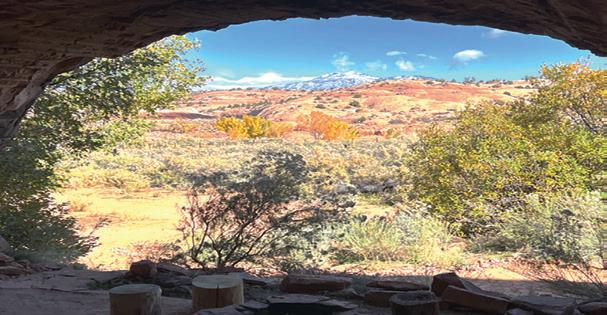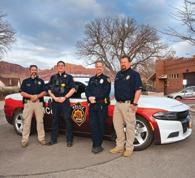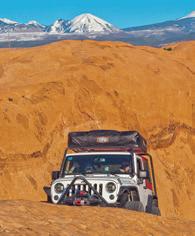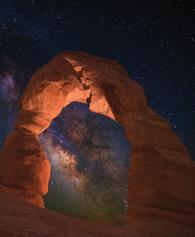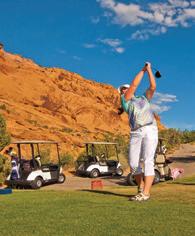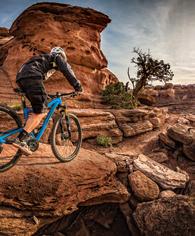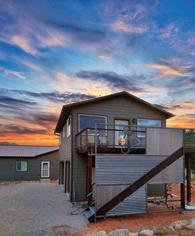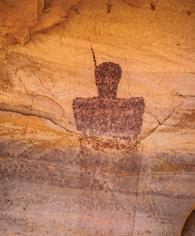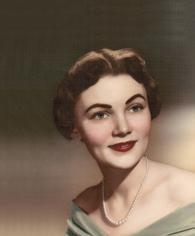THE MINES THAT PUT MOAB ON THE MAP
New exhibit at Moab Museum showcases the lives and legacy of southeastern Utah’s uranium era
Written by Rachel Fixsen
A BRIGHT RED SIGN ONCE GREETED VISITORS AS THEY CAME TO TOWN.
“ENTERING MOAB, UTAH,” IT SAID. “URANIUM CENTER OF AMERICA.” THE TOWN’S POPULATION AT THE TIME, ACCORDING TO THE SIGN, WAS 2,715.
Mining, especially uranium mining, defined an era of Moab’s past. The Moab Museum will explore that era in a two-phase exhibit, opening February 15, called “U92: Moab’s Uranium Legacy.” (U is the atomic symbol for uranium on the periodic table and 92 is the element’s atomic number.)
Uranium put Moab on the map and it shaped the lives of many Moabites whose families still live in the area.
“We’ve known for a long time that we wanted to do an exhibition on uranium,” says Tara Beresh, curatorial and collections manager for the museum, “but we also knew that
we wanted it to be big, and we had floated the idea of transforming the whole space.”
With the museum closed for several weeks over the winter, staff and volunteers have had time to put together an immersive, interactive display that brings Moab’s mining days to life.
Opposite page: A sign that once stood near Moab indicates the importance of uranium mining to the area. [Courtesy of Moab Museum] Large photo above: Miners and carts transport uranium ore out of Radium King Mine, Red Canyon Mining District in San Juan County. Date unknown. [Moab Museum Collection] Small photo: Mining tools and dynamite crates await installation in the faux powder magazine exhibit at the Moab Museum. [Courtesy of Moab Museum]
MINING IN MOAB
Most Moabites will be familiar with the name and legacy of Charlie Steen, the prospector who struck it rich in uranium in the 1950s. But the extraction of radioactive deposits in the Moab region goes back to the early 20th century. Around the turn of the century, Marie Curie and her husband Pierre Curie were researching radium (which can be extracted from uranium ore), and a market emerged for the element to be used in medical treatments.
In his book “A History of Grand County,” historian Richard Firmage wrote, “Radium was considered a major medical wonder drug, touted as a cure for many ailments and included in the ingredients of medications of many sorts, most of which would appall present-day medical practitioners.”
Late Moab local Gerald R. Swasey self-published a book on the history of uranium mining on Polar Mesa at the north end of the La Sal Mountains.
“The first mining in this area was for gold in 1888,” Swasey wrote. When those gold miners heard about uranium discoveries in other parts of southeastern Utah, “the word was out about… something that would pay as much as gold.”
Swasey’s 120-page book is based on stories passed down by his father-inlaw, who mined on the mesa starting in the 1940s, and on his own experiences working in the Polar Mesa mines in the 1950s. He details how miners used mules to transport materials and operate the mines, and how they built an office, blacksmith shop, and homes on the remote mesa.
Beresh, along with the museum’s Marketing and Membership Coordinator Diego Velasquez, visited the remains of mining activity on Polar Mesa, guided by a longtime local familiar with the area.
“It’s astonishing to see the length that people went to find hot rocks,” Velasquez says, showing photos of the remote, rugged terrain of Polar Mesa. “They built an airstrip out there, they spent the winter out there.”
“We wanted to see sites, to glean in person a little bit about the lengths that people would go to mine,” Beresh adds.
Vanadium, an important element in refining and hardening steel, was also found in the Moab region.
“Vanadium was often found in conjunction with uranium in what was known as carnotite ore,” Firmage writes,
Large photo: Museum Curatorial and Collections Manager Tara Beresh holds a replication of the photo album in the case behind her. Museum guests will be invited to view photos from remarkable documentation of work at Rio Algom from start to finish. The album was donated by the late Joe Vancil who worked for Rio Algom. [Courtesy of Moab Museum] Small photo: A helmet worn by Loretta Kraai is a reminder that women were part of the labor force in the uranium mining industry. [Courtesy of Moab Museum]
but large deposits discovered in South America undercut U.S. production of vanadium in the 1920s. There was a brief resurgence of demand for domestic vanadium extraction in the 1940s.
The uranium boom of the 1950s is the most famous part of Moab’s mining era. The Atomic Energy Commission, created in 1946, was tasked with regulating U.S. uranium production. The Cold War spurred the industry and, in the 1950s, people flocked to the region hoping to get rich quick. Steen discovered his successful Mi Vida mine, estimated to contain more than a million tons of uranium ore, in 1952.
“Within a short time, the hitherto bustling area was even more radically transformed into an almost unbelievable hive of activity, with thousands of claims being registered,” Firmage writes.
Beresh says staff will bring out various pieces of historic mining equipment from the museum’s collection, like an array of Geiger counters, to illustrate the frenzy of the era.
While the 1950s uranium boom has a strong hold over the public imagination, the industry continued to be critical to the Moab economy into the 1980s. Beresh, while researching for the exhibit, spoke with Vietnam War veterans who found employment and a way to reassimilate into civilian life by joining the mining industry in the 1970s.
In the 1960s, the local uranium mill was bought by the Atlas Minerals Corporation, which also owned several mines and operated into the 1980s. The old site of the mill is now the Uranium Mill Tailings Remedial Action (UMTRA) project on the north end of Moab. The U.S. Department of Energy has been removing the tailings by rail and storing them in disposal cells near Crescent Junction for over a decade.
Mike Price was the last geologist to work for Atlas before the mill and mines were shut down. He still spends much of his time in Moab, and has been helping museum staff develop the U92 exhibit.
Price says that technology advancements in the 1970s facilitated another, though less dramatic, uranium boom.
“We developed new ways to go look for radioactive minerals,” Price says. “We could look more efficiently, and we found more stuff, basically.”
Price worked both in the field and the office. He spent over a year mapping rock in the region, traveling from Crescent Junction west to Colorado, south through Uravan and to La Sal Creek, eventually looping back to Moab, “taking samples, making maps, measuring stratigraphic sections, mea-
Small
suring how thick the sandstones are, walking out there with a scintillation counter and a pick,” he says.
Price worked in the mining industry all over the West. But for him, Moab has been home since he first came in the 1970s.
“It was a really interesting town in those days,” he says. “It was very lively— we had two or three bars in town, people would get crazy on the weekends, you’d hear about it on Monday.”
By the early 1980s, however, it became clear that the mining industry in Moab was winding down. Price
The museum will be displaying a variety of uranium glass courtesy of Moab local Lin Ottinger. In this image, Museum Curatorial and Collections Assistant Allie Donnell shows a unique candy dish beneath a blacklight. [Courtesy of Moab Museum]
Large photo: Uranium miners setting “props” used to support the ceilings of the mine tunnels. [Moab Museum Collection]
photo:
saw three rounds of layoffs at Atlas; he stayed employed, but watched friends and colleagues get let go.
“Mines were shutting down, people were moving out by then,” Price says. “A lot of yard sales and saying goodbye to friends—and they went off to something else.”
For some of the 1980s, whole neighborhood blocks were vacant, Price says. Many people moved on to continuing mine operations in Nevada or Colorado. Others went into retail or trading stocks. Price himself transitioned to use his mapping skills for public safety, such as fire and flood planning, something he had been doing since the 70s.
“It was pretty sad, actually,” Price remembers. “Everybody was leaving, families were breaking up, going different directions. And kids that wanted to come back here and work some day, and stay in the area, knew that they wouldn’t.”
DEVELOPING THE EXHIBIT
The Moab Museum has been around since the 1950s, and in its current location since the 1980s. In recent years, the building underwent a major renovation and the organization updated its approach to exhibits and storytelling. After a long closure, the museum reopened to the public in 2021. Under its new brand, staff create rotating exhibits focused on specific stories from the region’s history, and host events like demonstrations, classes and talks to enrich those stories. The new approach is getting kudos: the Utah Historical Society awarded its Outstanding Achievement award to the Moab Museum this year.
“By offering public programs, partnerships, and community-led projects, the museum has set a new standard for rural museums, ensuring that Moab’s cultural legacy is both accessible and relevant to a broad audience,” the Utah
Historical Society wrote on its website.
To make room for these new exhibits, though, some of the objects once displayed in the museum’s old, static exhibit have been put into storage.
“A lot of people really care about the mining history,” Beresh says. “The new design doesn’t have a ton of objects on display.”
Since its reopening, the museum has been striving to tell and host stories that have received less attention, showcasing exhibits on the Japanese American incarceration center north of town, for example, and on Navajo fiber-making and weaving traditions. Some local museum-goers missed the mining exhibits they remembered. Museum staff are excited to bring that story back into the spotlight.
“Doing this exhibition, we want to do it right,” Beresh says. “It starts from talking to the people who are closest to those stories and letting them inform how that story is told.”
Large photo: Karen Keeler is crowned 1955 Miss Atomic Energy in Grand Junction, Colorado, winning a truckful of uranium ore. [Courtesy of Museums of Western Colorado, AEC & Chenoweth Collection] Small photo: Decommissioned signs on loan to the Moab Museum from a local retired miner paint a picture of uranium boom times. [Courtesy of Moab Museum]
Beresh has spent dozens of hours across a year and a half talking with around 30 people who worked in the mines or who had family members who worked in the mining industry.
“The biggest things that I distill from these meetings are the feelings,” Beresh says. In her interviews, people expressed appreciation for the opportunities the industry gave them to establish themselves, provide for their families and build wealth.
“I heard gratitude,” she says. “They talk a lot about the friendships that they made. They talk a lot about being grateful that they were able to make good money… they’re happy in reflecting on their experiences. Pride—that is what I got a lot from the different interviews, was pride.”
Staff will incorporate portraits of mine workers and direct quotes from them to convey those feelings in the exhibit.
It’s not just the people who made it big, it’s not just the mill owners,” Beresh says of the portraits. “It’s the people who were doing the work, the people whose descendants live here and still live and breathe that history of their fathers or their grandfathers.”
The ambitious exhibit will have immersive elements like a life-size faux mine being constructed by a talented volunteer, and interactive elements, like a game that challenges visitors to consider everyday items and identify elements on the periodic table that are essential to those items. The museum will also host guest speakers and events such as tours of the UMTRA site in conjunction with the exhibit.
TWO PHASES
The first phase of the exhibit focuses on the experiences, perspectives and feelings of people who lived through Moab’s mining era, as well as the lasting reminders on the local landscape today: things like the UMTRA site and the many roads once used for min-
ing that are today used for recreation access and travel.
A second phase, which will open in July, will examine the impacts of mining on the environment and human health—things like increased rates of cancer linked to the uranium industry, and potential water, air and soil contamination linked to uranium mining.
“We’ll be diving into the flip side of that personal experience of uranium,” Velasquez says. That next phase will also be guided and shaped by primary sources.
“I want the community of Moab to really see the effort we have put into, not necessarily glorifying uranium mining, but showing that we care about this story, and we care about the community story—all of the community stories,” Beresh says.
Price hopes the exhibit will help people remember that “Moab was a uranium town for about 50 years.
“That’s part of its history and culture,” he says, though he doubts that
Moab will ever have a mining-dominated economy again.
“Most of Moab has kind of forgotten about mining,” Price said, “so it is nice to have this exhibit, just so everybody can kind of reflect or remember that ‘yeah, it was like this.’ There’s enough families in town now whose grandpas or great-grandpas used to work in the mines, so they’ve probably heard a few stories. It’ll be fun to see it.” n
Large photo: A relic of the uranium boom, old mine equipment still stands on the remote Polar Mesa area outside of Moab. Prospectors went to great lengths to develop mines in some of the most rugged and seemingly inaccessible parts of canyon country. [Courtesy of Moab Museum] Small photo: In an exhibit featuring mining prior to the uranium boom, the museum showcases a pack saddle/container fashioned from an old car hood and used for carrying ore. [Courtesy of Moab Museum]
THE DESERT’S RIPARIAN SOUL
1389 Powerhouse Lane / MLS 1970590
2 BD | 1 BA | 1,159 SF | 24.76 AC | 1,000 ft of Mill Creek Frontage
Additional 2 BD/ 1 BA caretaker home | $4,995,000
Two magical parcels of Mill Creek acreage. Together, these properties will form a desert estate of over 30 acres with 2,000 feet of Mill Creek running through the private property, abutting thousands of acres of public land. 1389 Powerhouse Lane highlights a 24-acre Moab estate, bordering Mill Creek, with over 1,000 ft of tranquil running water and direct access to Mill Creek Canyon’s trails, including a contemporary 2-bed home with wraparound deck, a spring with deeded water rights, and a charming farmhouse. 1435 Powerhouse Lane features a 7.95-acre desert retreat with 1,000 ft of creek frontage, private waterfall, and lush riparian valley. Includes city water, well, and spring rights, and approved plans for a 6-bed, 6-bath modern house. Both properties are situated just 3 minutes from Sand Flats Road, 7 minutes from downtown Moab, 17 minutes from Arches National Park, and 40 minutes from Canyonlands National Park.
MILL CREEK OASIS
1435 Powerhouse Lane / MLS 1864833
1,000 ft of Mill Creek Frontage
7.95 AC | $995,000
video
This remodeled 4-bed, 2-bath home offers modern updates throughout, including new luxury vinyl, updated kitchen, and efficient systems. Enjoy stunning views, a fenced yard, and a prime Moab location!
Rachel Moody Team (435) 260-8240
Nikole Andersen (801) 750-5280
3
CLASSIC BRICK RAMBLER
491 Mountain View Drive
4 BD | 3 BA | 2,303 SF | 0.22 AC
$579,000 | MLS 1979292
Rachel Moody Team (435) 260-8240
MOAB RIM VIEWS
2525 Roberts Road
3 BD | 2 BA | 1,616 SF | 0.52 AC
$565,000 | MLS 20449964
Kerby Carlisle-Grant (720) 480-0890
MAKE YOURSELF AT HOME
370 Marcus Court
4 BD | 2 BA | 2,470 SF | 0.29 AC
$599,000 | MLS 2007286
Rachel Moody Team (435) 260-8240
Corah Moody (435) 260-0255
COUNTRY FEEL 35 N Mount Peale Drive 4 BD | 2 BA | 1,732 SF | 1.00 AC $585,000 | MLS 2029184
Shannon Meredith (435) 260-7484
| MLS 2026568
Rachel Moody Team (435) 260-8240
KANE CREEK CONDOMINIUMS
443 Kane Creek Blvd #A204
1 BD | 1 BA | Den | 710 SF
$375,000 | MLS 2024094
Live and play in Moab! This upper-level condo features a bedroom, large flex room, vaulted ceilings, private balcony and modern finishes. Just minutes from downtown, trails, and Moab’s iconic scenery.
Rachel Moody Team (435) 260-8240
WILSON ARCH - PHASE 2
73 Parcels, Fully Platted & Engineered
147 AC | $1,999,000 | MLS 1845590
Rachel Moody (435) 260-8245
Nikole Andersen (801) 750-5280
WILSON ARCH COMMERCIAL LOTS
5 Commercial Lots
2.16 - 5.68 AC | $220,000-$360,000
Residential Listings Residential Listings
Rachel Moody Team (435) 260-8240
Nikole Andersen (801) 750-5280
WILSON ARCH RESIDENTIAL
49 W Ryan Court, Lot 2 | 1.33 AC
$130,000 | MLS 1897370
Rachel Moody Team (435) 260-8240
Shannon Meredith (435) 260-7484
OPPORTUNITY ABOUNDS
Commercial Lodging Acreage
4.67 AC | $2,900,000 | MLS 2016046
Corah Moody (435) 260-0255 Rachel Moody Team (435) 260-8240
YOUR ISLAND IN THE SKY
1650 Vertigo Drive
3.66 AC | $325,000 | MLS 1902029
Rachel Moody (435) 260-8245 Shannon Meredith (435) 260-7484
WHITE HORSE
4122 Lipizzan Jump, Lot 33 | 0.50 AC | $175,000 | MLS 1838551
4265 Lipizzan Jump, Lot 18 | 0.50 AC | $225,000 | MLS 1864162
Rachel Moody Team (435) 260-8240
GATEWAY TO MOAB
CR 223, Crescent Junction
613.23 AC | $340,000 | MLS 1980811
Shannon Meredith (435) 260-7484
RUSTIC COMFORT
This established and popular 3 bedroom, 2 bathroom vacation rental is set on half an acre in Moab’s South Spanish Valley. Great proximity to Ken’s Lake, the La Sal Mountains, and popular off roading trails. Enjoy vaulted ceilings, vibrant living spaces, and patio access with your selection of conversation and BBQ areas.
Moody Team (435) 260-8240
RIM VILLAGE B1
3686 Spanish Valley Dr B-1
2 BD | 2 BA | 1,573 SF | $699,000 | MLS 2007384
Nikole Andersen (801) 750-5280
RIM VILLAGE VISTAS 9A1
3862 Desert Willow Cir 9-A1
3 BD | 2.5 BA | 1,520 SF | $675,000 | MLS 1970819
Rachel Moody Team (435) 260-8240
RIM VILLAGE VISTAS 9A3
3862 Desert Willow Cir 9-A3
3 BD | 2.5 BA | 1,478 SF | $599,000 | MLS 2012531
Rachel Moody Team (435) 260-8240
OWN YOUR RV PAD!
1261 N Main Rubicon Trail #27
0.09 Acres | $269,900 | MLS 1898426
Residential Listings Residential Listings
Rachel Moody Team (435) 260-8240
APACHE MOTEL
166 South 400 East
15,483 SF - 35 ROOMS | 0.95 AC
$6,750,000 | MLS 1979847
Rachel Moody (435) 260-8245
Nikole Andersen (801) 750-5280
Saddle up to the Apache Motel, Moab’s most iconic boutique motel. 35 rooms, including the John Wayne suite- where your guests can stay where John Wayne stayed! An ultramodern build in 1955, this registered historic landmark was the home for Hollywood’s Classic Western’s elite and is now the retro-modern motel on the path to Sand Flats Recreation Area servicing bikers, jeepers, weary travelers, and National Park enthusiasts.
584
Scandinavian inspired bungalow with the Moab Rim as a backdrop. Large windows welcome natural light in the open kitchen and living area. A custom island houses the range and provides a stage to soak in the natural light and intimate conversations. A full bathroom is located just off the main living area. There are three bedrooms set at the back of the home. A sliding glass door in one of the bedrooms opens into the lovely yard with trees for shade and views of the Moab Rim. The second of the three bedrooms includes a private half-bath. A large, covered storage space behind the carport would make an excellent workshop or place to store items that support adventures.
Angela Houghton (435) 260-0700
BEDS
40 secluded acres in Cisco near Kokopelli trail. Rock formations, spring carpets of wildflowers. $189,000. MLS #2021297
Secluded acreage in Old La Sal with rock outcroppings, pine, oak, views of Mt. Peale and Paradox Valley. 5 acres: $81,000, MLS #2010591
PORTAL VIEW TOWNHOME
Open living concept, vaulted ceilings and abundant natural light, plus a short distance to downtown Moab, make this a convenient and carefree place to call home. A sliding glass door to the back patio and grassy common space leads to a tranquil and maintenance-free yard. The master bedroom with private ensuite full bath and walk-in cedar-lined closet, guest bedroom with adjacent three-quarter bath, private front courtyard patio, and spacious two-car garage combine to create a comfortable, modern living space with room to spare.
| $495,000
Stunning 0.25 acre lot in Wilson Arch Resort dotted with mature piñon and juniper. $72,000. MLS #1976103
Spring into the season’s upcoming events
Written by Sharon Sullivan
Whether you’re an athletic, outdoorsy type, into gardening or enjoy arts and culture, there is a plethora of events and activities coming up in the Moab area this spring.
MARCH
The Youth Garden Project (YGP) will host its annual online Auction Fundraiser, Feb. 26-March 4, at www.biddingforgood.com/youthgardenproject. All proceeds benefit YGP youth and community programming.
It’s growing season and Easy Bee Farm will open up its farmstand, starting Wednesday, March 5 www.easybeefarm.com
Transrockies Race Series, of Canada Run the Rocks, March 7-9, a three-day trail running race. This event is currently sold out, but the same organizer also puts on Gravel Fondo Moab – a road cycling event that happens May 3 and 4
Pints for Parks is a fundraiser for Friends of Arches and Canyonlands National Parks that takes place March 9, 5-9 p.m. at Proper Brewing, 1393 N. Hwy 191. All proceeds from ticket sales, ticket drawing purchases, and merchandise will directly support the Friends group. The evening will include live music, a short presentation on
projects in local parks, and prizes. The price of a ticket will get you a souvenir glass, a drink ticket, and five prize drawing tickets. www.foacp.org
The 24th annual Skinny Tire Festival takes place March 8-11 (with a choice of four- or two-day events). The four-day ride takes participants through Arches National Park, while the two-day event travels through Dead Horse Point State Park and back. Both events include riding along the Colorado River. www.skinnytireevents.com/skinny-tire-festival
Mad Moose Events puts on the Run Moab Series each year, starting March 15, with the Canyonlands Half Marathon and 5 Mile – known locally as the Moab Half Marathon
The course begins at Sandy Beach, a boat launching site next to the Colorado River before traveling east for a half mile and turning around to head toward Moab Valley. Runners finish at Lions Park, next to Arches National Park. Runners World UK magazine mentioned the Moab Half Marathon in its article “The World’s Greatest Races.”
Opposite page photo courtesy Transrockies Race Series. Photo above courtesy Moab Arts Festival.
This is a big year for Canyonlands Half Marathon,” says Race Director Denise Ricks. “We will be celebrating the 50th annual event and we’re expecting a large turnout” by both local and out-of-town runners.
This year’s event will include the Taiko drummers (a Moab group that practices the Japanese drumming artform) out on the course. Organizers will also hand out special 50th anniversary medals and shirts, says Ricks.
The Castle Valley Library Branch will host free movie screenings Thursday, March 20 (The Bank of Dave), and April 17, (Fried Green Tomatoes). www.moablibrary.org
Another Mad Moose event, March 22, is the Behind the Rocks Ultra, which includes 10-mile, 30K, 50K, and 50 mile runs, starting and ending at the Behind the Rocks Trail, along the Border of the Behind the Rocks Wilderness Study Area. The 10-Mile and 30K are considered an introduction to Moab trail running, while the 50-Mile course, with its technical down climbs and rim running, is one of Mad Moose’s most challenging events. There’s free camping at the start and finish lines. www.madmooseevents.com/runmoab
APRIL
The 2025 Moab ArtWalk kicks off April 4, from 5-8 p.m. in downtown Moab. Presented by the city’s Moab Arts, community members are encouraged to walk a loop to visit participating art galleries to mix, mingle and meet featured artists who will be present that evening to talk about their
work. ArtWalks are held on three different months, each spring and fall.
The city’s Arts and Special Events Director Kelley McInerney notes the ArtWalks are popular with local residents. “It means seeing your friends and neighbors while strolling the downtown locations and maybe even discovering one of them is among our talented artists,” McInerney says. “It is a fun and unique experience each time. They are evenings I always look forward to.” www.moabarts.org/moab-artwalk
Top photo courtesy Green River Dirt Bike Rally. Bottom photo by Diego Velasquez.
Rock and gem enthusiasts may want to attend the Green River Rocks Festival, April 4-6. It’s a free, weekend-long event based at the John Wesley Powell River History Museum, 1765 E. Main St., in Green River, Utah. “The purpose is to explore the paleontology, geology and archaeology of the area,” says organizer Alison Jean Cole. The event includes scientist-led field trips to research sites on Saturday and Sunday. Field trip leaders also include longtime Emory County residents who have extensive knowledge of the area.
Green River Rocks kicks off Friday evening with a lecture at the museum. That’s where you can also sign up for field trips, all of which depart from the museum. Then, on Saturday, there is a rock and gem show at the museum, which will include rough rocks, arts and crafts, plus information booths. The Bureau of Land Management, and the nonprofit Epicenter are organizers of the event. www.greenriverrocks.com
The 11th annual Moab Rocks bike race happens April 5-7. The three-day event includes three supported stages over 76 miles, reaching elevations of 7,800 feet. www.moab-rocks.com
Yet another athletic event – Running Up For Air – takes place April 5. It’s a collection of endurance events for athletes “created to support improved air quality, while having fun hiking and running on great trails with good people.” Salt Lake City resident Jared Campbell founded the nonprofit Running Up For Air in 2012 to raise awareness and funds to improve air quality by holding events in
Colorado, Utah, and Washington. Participants choose between three, six, or 12-hour events where they see how many laps they can complete. The course starts at the Moab Rim Trailhead, from where participants hike or run up the Stairmaster Trail before turning around to descend the parallel Moab Rim Trail. upforairseries.org
The city of Moab is sponsoring its annual Easter Egg Hunt, Saturday, April 8, at Swanny City Park. The hunt starts at 10 a.m. and is free for the public. www.moabcity.org/642/Recreation-Special-Events
The Green River Dirt Bike Rally happens April 10-12. Visit the web site: www.greenriverdirtbikerally.com to register and see detailed maps of various designated trails of every skill level. Those who register will receive a GPS map containing all the trails along with their skill ratings. The Green River event includes door prizes and bike/gear demos.
More Mad Moose events take place in April. The Amasa Trail Race, a long-distance running event, happens on April 12 Participants choose from either a 25K or 15K run through Moab’s treasured trail systems that include petroglyphs, the famous whale rock, canyons, and the Colorado River.
The Easter Jeep Safari is scheduled for April 12-20 and includes day-long trail rides that depart from Moab. The event is hosted by Moab’s oldest four-wheel drive club –Red Rock 4-Wheelers. For more information or to register for this event, visit: www.rr4w.com. The Easter Jeep Safari Vendor Expo is a gathering of four-wheelers where vendors display their products on Thursday and Friday, April 17 and 18
Top photo by Ryan Baxter. Bottom photo courtesy Transrockies Race Series.
The Youth Garden Project’s Weed N Feed volunteer nights begin on Wednesday, April 16 and continue every other Wednesday until (date) from 6-8 p.m.
Cruise Moab, April 23-27, is a Toyota, four-wheel-drive event that includes guided trail rides, a vendor s howcase, Friday night dinner and raffle, plus more. www.cruisemoab.com
In Moab, April 25-27, the 33rd annual Moab Rotary Car Show will take place at Swanny City Park. The car show is free to attend for patrons, with food vendors and musical entertainment onsite throughout the weekend. www.moabrotary.com
There’s a three-day horseback ride – Canyon Rims Endurance Rides, April 25-27. The ride is based out of the Hatch Mesa camp in the Canyon Rims Recreation area, one hour south of Moab. Participants ride out from camp each day across mesa tops and into canyons and high desert landscape. https://mickeysmt.wixsite.com/ moabenduranceride/moab-canyon-rims-ride
The Thelma and Louise Marathon, Half-Marathon, and 15K all take place April 26 – with views that include red rock walls of Lone Rock, a maze of fins in the Behind the Rocks Wilderness Area, and the snow-capped La Sal Mountains. www.madmooseevents.com/runmoab
The Youth Garden Project’s annual Spring Plant Sale will take place Saturday, April 26, 9 a.m.-1 p.m.
Top photo courtesy of Jeep Safari/RR4W. Bottom photo courtesy Transrockies Race Series.
MAY
The Arts and Ag Market will open May 2, offering locally grown produce and various artisanal goods. Live music will be performed during the event. www.moabarts.org/arts-and-ag
Transrockies Race Series of Canada Gravel Fondo Moab – a road cycling event that happens May 3 and 4.
More off-roading happens May 9-12, during Raptors on the Rocks, based at the Old Spanish Trail Arena, 3641 S. Hwy 191. www.raptorsontherocks.com
The C10 Red Rock Retreat is a Classic GM Truck event that happens on May 17, near Arches National Park. Organizers call it an opportunity to “rest and relax with beautiful GM
trucks under the Red Rock Cliffs. A large silent auction will benefit the Grand County Search and Rescue Team. https://c10redrockretreat.com
Barrels 4 Bucks takes place May 17 and 18 at the Old Spanish Trail Arena. www.barrels4bucks.mysite.com
The Free Movie Moab Summer Film Series kicks off May 19, with the screening of The Bad Guys at Swanny City Park. Movie start time is approximately 8:30 p.m. Moviegoers are encouraged to bring chairs, blankets, and water. Popcorn will be provided, and alcoholic beverages will be available for purchase. www.moabcity.org/Calendar
The Moab Arts Festival, an annual gathering of artists, musicians, and community members at Swanny City Park, takes place over Memorial Day weekend, May 25 and 26 This free event includes local and regional artists showing and selling their unique, hand-crafted items. It’s a popular, festive event that includes performance art, and children’s activities throughout the weekend. www.moabartsfestival.org
The Canyonlands PRCA Rodeo happens May 30-June 1 Attendees can watch classic rodeo events such as steer wrestling, saddle bronco riding, team roping, calf roping, barrel racing, bull riding and bareback riding. www.moabcanyonlandsrodeo.com/rodeo-events
Spring is coming and it’s time to get out and about! n
Top photo courtesy of PRCA. Bottom photo by Tom Haraden.


